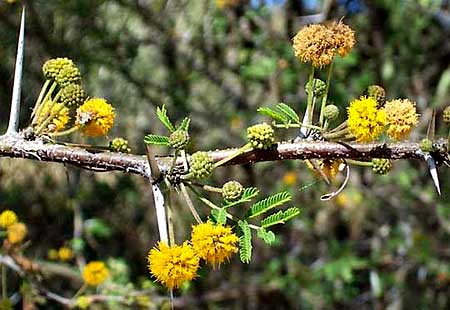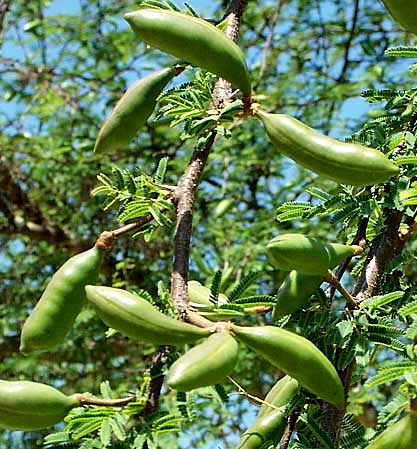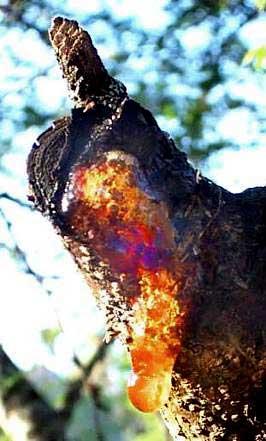
Sweet Acacia is Vachellia farnesiana, until recently known as Acacia farnesiana. In arid northern Mexico where it's abundant it's known as Huisache (we-SACH-eh) but the Maya call it something like Ka'an kilis che. It flowers much of the year but seems to reach a peak during the early dry season. Sometimes it gets absolutely loaded with tiny, yellow flowers clustered into globular, mothball-size heads on zigzagging branches with 1.5-inch long (4cm), white spines and feathery leaves as shown below:

In the Yucatan Sweet Acacia is most common in the arid northwestern corner. Since it produces abundant flowers during the dry season when many trees and bushes are in "suspended animation" because of the lack of rain, Sweet Acacia flowers produce a lot of nectar, which attracts many pollinators, including honeybees. Thus this tree is very important to the Yucatan's honey industry. Many insectiverous birds visit the flowers, feeding on the smaller insect pollinators.
Sweet Acacia's legumes are short, pudgy items, as shown below:

Interestingly, some of the world's finest, most expensive perfumes are based on an essence called "cassie," which is extracted from Sweet Acacia flowers. To get cassie, macerate the flowers and mix with melted, purified fats until the fats are saturated with fragrance. Then re-melt the fats, strain and cool. This results in a kind of salve that in some cultures is used as pomade for dressing hair. If alcohol is mixed with the salve and left standing for about a month at below-freezing temperatures the fragrance transfers to the alcohol. When you distill this, the alcohol evaporates leaving a viscous, yellow to brown liquid called "cassie absolute," which is the cassie of expensive perfumes.
 Not only that, but the resin that exudes from wounds on Sweet Acacia also is very useful stuff. At the right you see some hardened resin where a Sweet Acacia twig has broken off.
Not only that, but the resin that exudes from wounds on Sweet Acacia also is very useful stuff. At the right you see some hardened resin where a Sweet Acacia twig has broken off.
Maybe you have heard of "gum arabic," which is still used as a natural stabilizer and thickening agent in the food industry, particularly in soft-drink syrups, gumdrops and marshmallows. In the past it was used to adjust viscosity in inks. Gum arabic is normally collected by hand in its dried-hard, amber-like state and is often referred to as a 'tear' -- the very thing shown in the picture. Commercial gum arabic is produced by the African acacia species Acacia senegal. Thing is, some experts say that in certain cases gum produced from Sweet Acacia resin is superior to gum arabic produced by Acacia senegal!
By the way, when a wounded tree exudes resin drops, it's doing so because the gummy resin plugs up the plant's severed conducting tissue in a process called "gummosis." Resin is a lot like the clotting agents in our own blood when we cut ourselves.
What an incredibly useful tree! None of the Maya I have spoken to find Sweet Acacia of any value other than for firewood and for honey production.